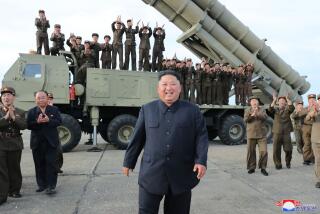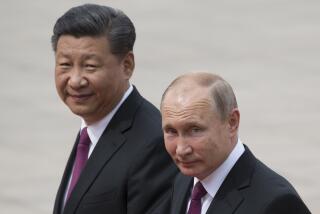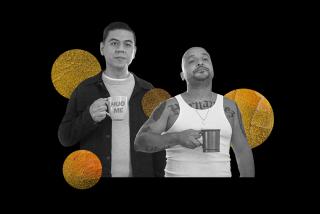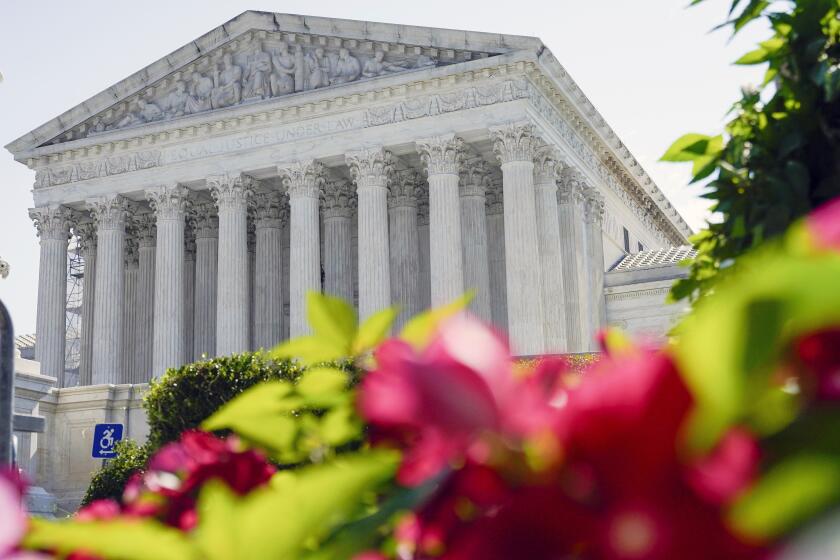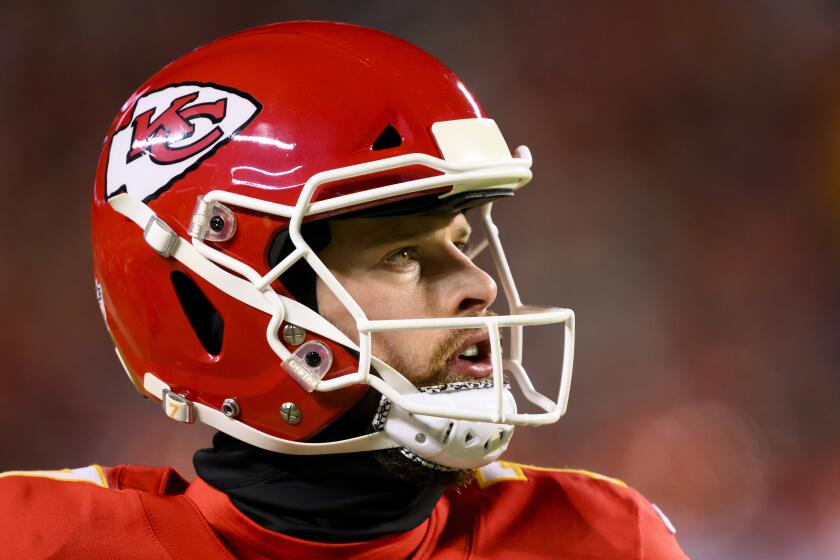Pointing a Finger at Prints
When Riky Jackson, a prime suspect in the 1997 murder of a friend, heard that police found bloody fingerprints at the crime scene, he thought he was off the hook.
“I was innocent,” said Jackson, a Philadelphia hairdresser. “There was no way they could have been mine.”
But three prosecution fingerprint experts said they were his, and he spent 2 1/2 years in prison before authorities acknowledged the error and set him free.
No one knows how often fingerprint experts send the wrong person to prison. Ever since fingerprints were first entered as evidence in American courtrooms nearly a century ago, the methods used for matching them have been virtually unquestioned. But mounting evidence cited in a series of legal challenges raises questions about whether the techniques for matching prints may be flawed.
Besides Jackson’s case, several other wrongful accusations based on fingerprints have been uncovered in the last 25 years. Moreover, nearly half the examiners who take national certification tests flunk the part that requires them to correctly match fingerprints. Yet they still can testify in court.
Last month, a federal judge in Philadelphia barred a fingerprint examiner from testifying that crime scene prints belonged to the defendants. The judge ruled that fingerprint comparisons are not strictly scientific, and he limited the expert to identifying matching details.
The ruling bolstered the contention of defense lawyers and others that examiners do not adhere to a uniform standard when matching fingerprints, and hence such findings are inherently subjective. Nor has the profession devised a way for determining how often examiners make mistakes.
Leaders in the field counter that their technique meets scientific muster in several ways, among them: They have been tested in the courts for decades; their findings in individual cases are subject to peer review; and fingerprinting is based on scientific research on the origin of fingerprints during fetal development.
Fingerprint practitioners may err, but properly followed, the methods for determining whether prints match do not, said Stephen Meagher, an FBI fingerprint analyst for 25 years.
“Its error rate is zero,” he said.
Challenges to fingerprint evidence are surfacing now because of U.S. Supreme Court rulings in 1993 and 1999 that set new, more stringent guidelines for judges in deciding when to let jurors hear experts of various kinds. The court said in part that judges should decide whether standard techniques are vulnerable to practitioner error and are applied in accordance with a uniform objective standard.
The outcome of the challenges could have major implications for courts and police. Fingerprints, along with DNA, are considered the “gold standard for forensic science,” said David Faigman, a Hastings Law School professor.
If courts routinely question the reliability of fingerprint examiners, other forensic tools such as fiber comparisons, bite mark analyses and firearm tests could also lose standing, he said.
Fingerprint Evidence Was Challenged
In fingerprinting, the first major challenge under the high court guidelines surfaced in 1999 in a Philadelphia armored car robbery trial in which two fingerprint marks found in the vehicle were key evidence.
Robert Epstein, an assistant federal public defender, offered evidence showing that fingerprint examiners’ standards vary from one agency to the next and that they frequently make mistakes on competency tests. He also showed how the FBI sent the two crime-scene prints along with his client’s fingerprints to state crime labs across the country and asked them to determine whether it was his client’s prints in the vehicle. Nearly a quarter couldn’t match one crime-scene print to his client, and almost one-fifth couldn’t match the other.
Epstein asked a judge to admit testimony questioning the reliability of the techniques. The judge refused.
But relying almost entirely on the hearing transcript in Epstein’s case, a judge in another Philadelphia trial ruled that the opinions of fingerprint experts on whether prints match are not reliable enough to present to the jury.
U.S. District Judge Louis H. Pollak, former dean of the law schools at Yale and the University of Pennsylvania, based the ruling in part on the grounds that there is no means of determining how often practitioners err when making identifications.
“This is a tremendous breakthrough,” Epstein said. “It’s a fully reasoned and analyzed opinion.”
U.S. Atty. Patrick Meehan, who is prosecuting the case, has asked Pollak to reconsider his decision at court hearings this week.
Pollak did concede one point to prosecutors. An individual’s fingerprints are unique and permanent, he wrote in his 49-page opinion, thus preserving them as a basis for identification.
Several Mistakes Are Found
In the last 25 years, several examples have turned up of fingerprint examiners identifying the wrong person in court.
In a 1977 Minnesota double murder case, defendant Roger Sipe Caldwell’s own fingerprint expert confirmed a prosecution examiner’s finding. The prosecution’s expert had matched 11 details in a crime scene print to Caldwell. A jury, relying on that opinion, convicted Caldwell of killing an elderly Duluth woman and her nurse. Caldwell was sentenced to two life terms.
The mistake was uncovered a year later in a co-defendant’s trial, when three other fingerprint examiners called by the defense found that Caldwell’s prints did not match. The co-defendant was acquitted, and Caldwell’s conviction was later reversed on appeal.
In the case of Riky Jackson, the Philadelphia hairdresser, one of the experts who erred was a veteran state examiner from Vermont who was certified by the International Assn. for Identification.
The prosecution, relying on him and two local experts, argued that eight details on the bloody print matched eight details on his print.
Jackson’s lawyer, Michael J. Malloy of Media, Pa., hired two experts, one a former FBI fingerprint examiner, who said the comparisons “weren’t even close.” The jury chose to believe the prosecution’s experts and found Jackson guilty. He was sentenced to life in prison.
Malloy and his two experts pushed for reexamination of the prints. After reviews by the International Assn. for Identification, another prosecution expert and the FBI showed the matches were wrong, the district attorney’s office acknowledged the mistake and agreed to Jackson’s release in December 1999.
Such cases “clearly show misidentifications happen,” Epstein said. “They are also significant in that you have very experienced examiners making these identifications.”
Epstein said he suspects those cases may be the “tip of the iceberg” because fingerprint errors show up routinely in various professional competency tests that examiners have taken over the years.
In a 1995 IAI-approved proficiency test, 22% of the test takers identified the wrong person one or more times. In addition, 36% could not identify prints that test givers said they should have been able to match, which means that a guilty person could have gone free in a real case.
Ken Smith, chairman of IAI certification, suggests the error rate may not fairly represent the profession because the test takers were anonymous and there was no way to determine their credentials.
But fingerprint examiner David Grieve, editor of the Journal of Forensic Science, said in an article that the test results were alarming and noted that reaction in the forensic science community “ranged from shock to disbelief.”
“Errors of this magnitude in a discipline singularly admired and respected for its touted absolute certainty . . . produced chilling and mind-numbing realities,” he wrote.
Examiners Have Difficulty Passing Test
Test results in 1997 and 1998 were better.
But people currently working as examiners have difficulty passing a certification test offered by the International Assn. for Identification. Close to 50% of the examiners who take it flunk, Smith said. One part requires examiners to compare crime scene prints with 15 sets of identified prints.
“That’s the part most people fail,” Smith said.
Those examiners can still testify in court. Certification may add credibility to an examiner’s testimony, but it is not a requirement.
Some leaders in the profession say error rates on such tests suggest more training is needed. But there are no mandatory training standards in the U.S. Each law enforcement agency establishes its own, resulting in a hodgepodge of classes, on-the-job training and seminars.
In Los Angeles County, the sheriff’s department requires 1 1/2 to two years of training, according to William Leo, a fingerprint examiner in the Scientific Services Bureau.
The Los Angeles Police Department requires its examiners to spend up to three years lifting prints at crime scenes before they can start learning how to make fingerprint comparisons, Capt. Paul Enox said. He said there is no set time for such training. Prospective examiners can start testifying in court whenever the department’s “quality assurance” program determines they have mastered the techniques.
Neither Los Angeles agency requires IAI certification for its examiners.
Pat Wertheim, a fingerprint analyst and trainer from Oregon, said the quality of training varies widely.
“You could have a rural county police department . . . where the police chief would walk in and pick someone to go to a weeklong school and say, ‘You be our fingerprint person,’ ” he said. “It is a sad state of affairs.”
Wertheim said training is much more rigorous in some other countries. New Zealand requires five years of training and passing a comprehensive competency test. Great Britain also requires five years, and the Netherlands, three to five years. All three set national training standards and require police agencies to abide by them, Wertheim said.
Training Involves Identifying Patterns
In most training, examiners learn to first study the crime scene print. The prints usually are fragmentary, blurred, smudged or distorted. The FBI estimates they are one-fifth the size of the inked print defendants give at booking.
Examiners try to identify the paths and patterns of a print’s ridges, their ending points, where they fork or intersect with a different ridge and other details. They try to find the same points on the suspect’s print. Examiners then say the two prints match if the likenesses are sufficient.
That last step raises the main question: What is sufficient?
Fingerprint examiners in the U.S. don’t have any single standard measure for determining when the likenesses are sufficient. Some examiners say they find at least eight matching details before identifying a suspect. Others use 10 to 12. Some other countries require 24 matching details.
That variation is another way the methods fail to meet the Supreme Court guideline that calls for a uniform standard controlling use of the techniques of expert witnesses, Pollak said in his opinion.
But defenders of fingerprint comparison techniques point out that until Pollak, no other judge had rejected their practices. They say their methods are repeatedly tested in court, where defendants can hire experts to challenge the prosecution’s expert. Moreover, they say their findings are usually verified by a second examiner.
Epstein counters that verifications of initial results are tainted because the second examiner knows the prints already have been matched to the defendant. Second, he said, until the recent challenges, judges had never been asked to rule on the legitimacy of fingerprinting techniques.
“There had been no adversarial testing [of the technique] in the last 100 years,” Epstein said.
More to Read
Start your day right
Sign up for Essential California for news, features and recommendations from the L.A. Times and beyond in your inbox six days a week.
You may occasionally receive promotional content from the Los Angeles Times.
